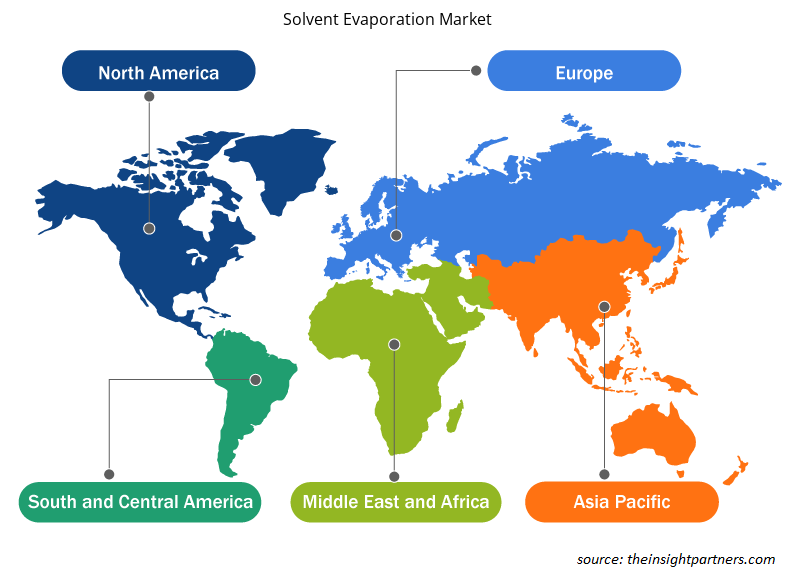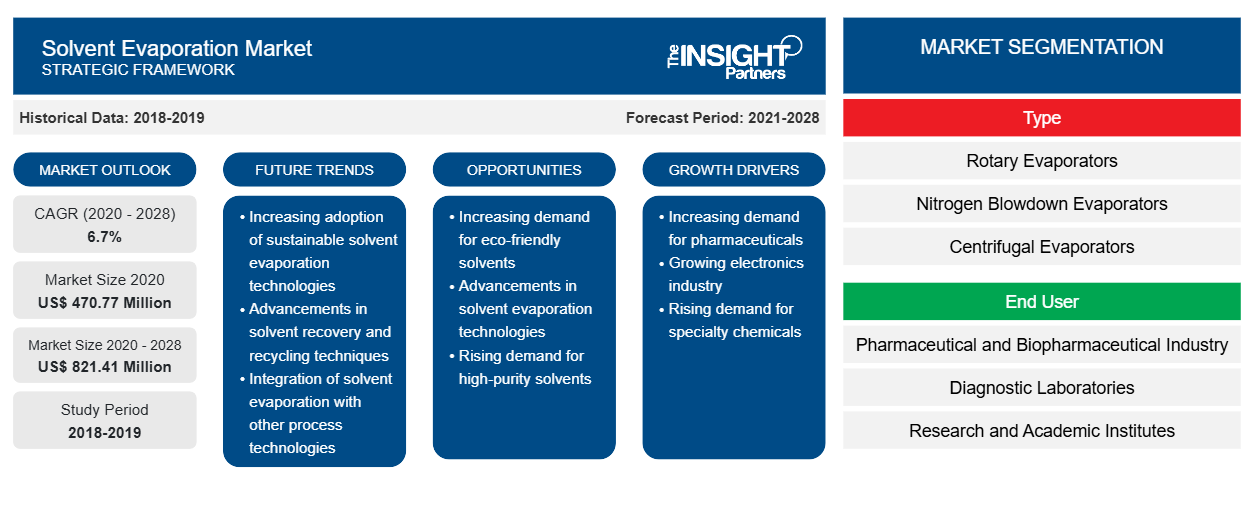2020 年溶剂蒸发市场价值为 4.7077 亿美元,预计到 2028 年将达到 8.2141 亿美元;预计 2021-2028 年期间的复合年增长率为 6.7%。CAGR of 6.7% during 2021–2028.
溶剂蒸发涉及聚合物在水相中的乳化和在二氯甲烷、氯仿和乙酸乙酯等挥发性溶剂中的分散。然后使用高温、真空或连续搅拌蒸发溶剂。可以通过调节参数(如控制蒸发温度、控制蒸发速率、控制搅拌速率等)来控制颗粒的大小。该方法正在用于使用各种聚合物(如 PLA、PLGA、PCL、聚羟基丁酸酯等)开发的纳米颗粒,其中装载有各种药物,如破伤风类毒素、睾酮、洛哌丁胺、环孢菌素 A 和吲哚美辛。溶剂蒸发器广泛用于微胶囊化等工艺,并且需要用于制备用于各种药物制剂的聚合物纳米颗粒。溶剂蒸发系统的技术进步,例如离心浓缩、冷冻干燥和高功率冷阱,增强了蒸发效果并提高了溶剂回收率,同时减少了对环境的影响。
研发支出增加、大分子生物制药不断发展、终端市场对纯样品的需求激增等因素推动了溶剂蒸发市场的增长。然而,由于与溶剂蒸发相关的不安感而导致的结果不准确和资源浪费阻碍了溶剂蒸发市场的增长。biopharmaceuticals, surging demand for pure samples in end-use markets drive the growth of the solvent evaporation market. However, inaccuracies in results and wastage of resources due to uneasiness associated with solvent evaporation hinder the
定制此报告以满足您的需求
您可以免费定制任何报告,包括本报告的部分内容、国家级分析、Excel 数据包,以及为初创企业和大学提供优惠和折扣
- 获取此报告的关键市场趋势。这个免费样品将包括数据分析,从市场趋势到估计和预测。
市场洞察
制药行业研发支出增加
溶剂蒸发活性物质是药物发现过程中必不可少的步骤,因为它用于合成、样品制备和溶剂回收等阶段,以及新型疗法的大规模生产。许多制药公司在研发 (R&D) 过程中投入了巨额资金,主要围绕发现和开发创新分子。根据 Statista 发布的一份报告,2018 年全球在药品研发上的支出总计约 1810 亿美元,预计到 2026 年将达到 2230 亿美元。根据印度品牌资产基金会的数据,印度制药公司在 2015 年将其收入的约 7.0% 用于研发过程,2019 年研发投资增长了 8.6%。因此,增加研发支出正在推动溶剂蒸发市场的增长。Statista, the global spending on pharmaceutical R&D totaled US$ ~181 billion in 2018, and it expected to reach US$ 223 billion by 2026. As per the India Brand Equity Foundation, Indian pharmaceutical companies invested ~7.0% of their revenues in the R&D process in 2015 and R&D investment grew by 8.6% in 2019. Thus, increasing R&D expenditure is fueling the growth of the solvent evaporation market.
基于类型的洞察
根据类型,溶剂蒸发市场分为旋转蒸发器、氮气吹扫蒸发器、离心蒸发器和螺旋气流蒸发器。旋转蒸发器部分在 2020 年占据了最大的市场份额。然而,预计氮气吹扫蒸发器部分在预测期内的复合年增长率最高,为 7.4%。旋转蒸发器在通过蒸发有效提取溶剂方面起着重要作用,这是在多个行业中开发纯样品的重要步骤。研发支出增加以及与该技术相关的多项好处等因素正在推动溶剂蒸发市场的增长。blowdown evaporators, centrifugal evaporators, and spiral air flow evaporators. The rotary evaporators segment held the largest share of the market in 2020. However, the nitrogen blowdown evaporators segment is estimated to register the highest CAGR of 7.4% in the market during the forecast period. The rotary evaporator plays a major role in efficient extraction of solvent through evaporation which is an important step in developing pure samples in several industries. The factors such as increasing R&D expenditures and several benefits associated with this technique are propelling the growth of the solvent evaporation market.
基于最终用户的洞察
根据最终用户,溶剂蒸发市场细分为制药和生物制药行业、诊断实验室以及研究和学术机构。制药和生物制药行业在 2020 年占据了最大的市场份额。然而,由于药物开发研究的增加以及对现有产品的持续创新和改进的需求不断增长等因素,预计研究和学术机构部门在预测期内的复合年增长率最高,为 7.7%。biopharmaceutical industry, diagnostic laboratories, and research and academic institutes. The pharmaceutical and biopharmaceutical industry segment held the largest share of the market in 2020. However, the research & academic institutes segment is estimated to register the highest CAGR of 7.7% in the market during the forecast period. due to factors such as increasing drug development studies and rising demand for continuous innovation and enhancement of existing products.
在溶剂蒸发市场运营的各种公司使用产品发布、并购、合作、产品创新和产品组合扩展等策略来扩大其全球影响力、维护品牌名称并满足最终用户日益增长的需求。
溶剂蒸发市场区域洞察
Insight Partners 的分析师已详细解释了预测期内影响溶剂蒸发市场的区域趋势和因素。本节还讨论了北美、欧洲、亚太地区、中东和非洲以及南美和中美洲的溶剂蒸发市场细分和地理位置。

- 获取溶剂蒸发市场的区域具体数据
溶剂蒸发市场报告范围
| 报告属性 | 细节 |
|---|---|
| 2020 年市场规模 | 4.7077亿美元 |
| 2028 年市场规模 | 8.2141亿美元 |
| 全球复合年增长率(2020 - 2028) | 6.7% |
| 史料 | 2018-2019 |
| 预测期 | 2021-2028 |
| 涵盖的领域 | 按类型
|
| 覆盖地区和国家 | 北美
|
| 市场领导者和主要公司简介 |
|
溶剂蒸发市场参与者密度:了解其对业务动态的影响
溶剂蒸发市场正在快速增长,这得益于终端用户需求的不断增长,而这些需求又源于消费者偏好的不断变化、技术进步以及对产品优势的认识不断提高等因素。随着需求的增加,企业正在扩大其产品范围,进行创新以满足消费者的需求,并利用新兴趋势,从而进一步推动市场增长。
市场参与者密度是指在特定市场或行业内运营的企业或公司的分布情况。它表明在给定市场空间中,相对于其规模或总市场价值,有多少竞争对手(市场参与者)存在。
在溶剂蒸发市场运营的主要公司有:
- BUCHI 实验室技术股份公司
- 比奥塔吉公司
- LABCONCO 公司
- 海道夫仪器有限公司
- 大和科学株式会社
免责声明:上面列出的公司没有按照任何特定顺序排列。

- 获取溶剂蒸发市场顶级关键参与者概述
溶剂蒸发市场 – 按类型
- 旋转蒸发仪
- 氮气排污蒸发器
- 离心蒸发器
- 螺旋气流蒸发器
溶剂蒸发市场 – 按最终用户划分
- 制药及生物制药行业
- 诊断实验室
- 研究与学术机构
溶剂蒸发市场——按地区划分
北美
- 我们
- 加拿大
- 墨西哥
欧洲
- 法国
- 德国
- 意大利
- 英国
- 西班牙
- 欧洲其他地区
亚太地区 (APAC)
- 中国
- 印度
- 韩国
- 日本
- 澳大利亚
- 亚太其他地区
中东和非洲 (MEA)
- 南非
- 沙特阿拉伯
- 阿联酋
- 中东和非洲其他地区
南美洲 (SAM)
- 巴西
- 阿根廷
- 南美洲和中美洲其他地区
公司简介
- BUCHI 实验室技术股份公司
- 比奥塔吉公司
- LABCONCO 公司
- 海道夫仪器有限公司
- 大和科学株式会社
- 波尔韦尔公司
- IKA 工厂有限公司
- STEROGLASS 有限公司
- 组织协会有限公司
- KNF NEUBERGER, INC.
- 雷克尔
- 杏子设计公司
- 实验室技术有限公司
- 新月科学
- 信科股份有限公司
- 历史分析(2 年)、基准年、预测(7 年)及复合年增长率
- PEST 和 SWOT 分析
- 市场规模价值/数量 - 全球、区域、国家
- 行业和竞争格局
- Excel 数据集


- Medical and Research Grade Collagen Market
- Webbing Market
- Artwork Management Software Market
- Pressure Vessel Composite Materials Market
- Cosmetic Bioactive Ingredients Market
- Data Annotation Tools Market
- Ceramic Injection Molding Market
- Radiopharmaceuticals Market
- Truck Refrigeration Market
- Flexible Garden Hoses Market

Report Coverage
Revenue forecast, Company Analysis, Industry landscape, Growth factors, and Trends

Segment Covered
This text is related
to segments covered.

Regional Scope
North America, Europe, Asia Pacific, Middle East & Africa, South & Central America

Country Scope
This text is related
to country scope.
常见问题
Increasing R&D expenditure, a growing development of large-molecule biopharmaceuticals, increasing demand for pure samples in end use markets fuels the market growth and various technological advancements. As the solvent evaporation technique is widely used in sample preparation across pharmaceutical industries thus with the increasing use of this technology coupled with growing development in the novel drug is propelling the market.
Inaccuracies in results and wastage of resources due to uneasiness associated with solvent evaporation hinders the growth of the solvent evaporation market.
Solvent evaporation involves emulsification of polymer in aqueous phase and dispersion in a volatile solvent like dichloromethane, chloroform, and ethyl acetate. Then the solvent is evaporated using high temperature, vacuum, or by continuous stirring. Size of the particles can be controlled by adjusting parameters like manipulating evaporation temperature, controlling the rate of evaporation, manipulating stirring rate, etc. This method is being practiced for the nanoparticles developed using respective polymers such as, PLA, PLGA, PCL, polyhydroxybutyrate, etc. loaded with various drugs like tetanus toxoid, testosterone, loperamide, cyclosporin A, and indomethacin. Solvent evaporators are widely used in processes such as microencapsulation and are required to prepare polymeric nanoparticles for various pharmaceutical formulations. Technological advancements in solvent evaporation systems, such as centrifugal concentration, freeze-drying, and high-power cold traps, have led to enhanced evaporation and improved solvent recovery, with lesser environmental impact.
Trends and growth analysis reports related to Life Sciences : READ MORE..
The List of Companies - Solvent Evaporation Market
- BUCHI LABORTECHNIK AG
- BIOTAGE AB
- LABCONCO CORPORATION
- HEIDOLPH INSTRUMENTS GMBH & CO. KG
- YAMATO SCIENTIFIC CO., LTD.
- PORVAIR PLC
- IKA WERKE GMBH AND CO. KG
- STEROGLASS SRL
- ORGANOMATION ASSOCIATES, INC.
- KNF NEUBERGER, INC.
- RAYKOL
- APRICOT DESIGNS, INC.
- LABTECH S.R.L.
- CRESCENT SCIENTIFIC
- SCINCO CO.,LTD
The Insight Partners performs research in 4 major stages: Data Collection & Secondary Research, Primary Research, Data Analysis and Data Triangulation & Final Review.
- Data Collection and Secondary Research:
As a market research and consulting firm operating from a decade, we have published and advised several client across the globe. First step for any study will start with an assessment of currently available data and insights from existing reports. Further, historical and current market information is collected from Investor Presentations, Annual Reports, SEC Filings, etc., and other information related to company’s performance and market positioning are gathered from Paid Databases (Factiva, Hoovers, and Reuters) and various other publications available in public domain.
Several associations trade associates, technical forums, institutes, societies and organization are accessed to gain technical as well as market related insights through their publications such as research papers, blogs and press releases related to the studies are referred to get cues about the market. Further, white papers, journals, magazines, and other news articles published in last 3 years are scrutinized and analyzed to understand the current market trends.
- Primary Research:
The primarily interview analysis comprise of data obtained from industry participants interview and answers to survey questions gathered by in-house primary team.
For primary research, interviews are conducted with industry experts/CEOs/Marketing Managers/VPs/Subject Matter Experts from both demand and supply side to get a 360-degree view of the market. The primary team conducts several interviews based on the complexity of the markets to understand the various market trends and dynamics which makes research more credible and precise.
A typical research interview fulfils the following functions:
- Provides first-hand information on the market size, market trends, growth trends, competitive landscape, and outlook
- Validates and strengthens in-house secondary research findings
- Develops the analysis team’s expertise and market understanding
Primary research involves email interactions and telephone interviews for each market, category, segment, and sub-segment across geographies. The participants who typically take part in such a process include, but are not limited to:
- Industry participants: VPs, business development managers, market intelligence managers and national sales managers
- Outside experts: Valuation experts, research analysts and key opinion leaders specializing in the electronics and semiconductor industry.
Below is the breakup of our primary respondents by company, designation, and region:

Once we receive the confirmation from primary research sources or primary respondents, we finalize the base year market estimation and forecast the data as per the macroeconomic and microeconomic factors assessed during data collection.
- Data Analysis:
Once data is validated through both secondary as well as primary respondents, we finalize the market estimations by hypothesis formulation and factor analysis at regional and country level.
- Macro-Economic Factor Analysis:
We analyse macroeconomic indicators such the gross domestic product (GDP), increase in the demand for goods and services across industries, technological advancement, regional economic growth, governmental policies, the influence of COVID-19, PEST analysis, and other aspects. This analysis aids in setting benchmarks for various nations/regions and approximating market splits. Additionally, the general trend of the aforementioned components aid in determining the market's development possibilities.
- Country Level Data:
Various factors that are especially aligned to the country are taken into account to determine the market size for a certain area and country, including the presence of vendors, such as headquarters and offices, the country's GDP, demand patterns, and industry growth. To comprehend the market dynamics for the nation, a number of growth variables, inhibitors, application areas, and current market trends are researched. The aforementioned elements aid in determining the country's overall market's growth potential.
- Company Profile:
The “Table of Contents” is formulated by listing and analyzing more than 25 - 30 companies operating in the market ecosystem across geographies. However, we profile only 10 companies as a standard practice in our syndicate reports. These 10 companies comprise leading, emerging, and regional players. Nonetheless, our analysis is not restricted to the 10 listed companies, we also analyze other companies present in the market to develop a holistic view and understand the prevailing trends. The “Company Profiles” section in the report covers key facts, business description, products & services, financial information, SWOT analysis, and key developments. The financial information presented is extracted from the annual reports and official documents of the publicly listed companies. Upon collecting the information for the sections of respective companies, we verify them via various primary sources and then compile the data in respective company profiles. The company level information helps us in deriving the base number as well as in forecasting the market size.
- Developing Base Number:
Aggregation of sales statistics (2020-2022) and macro-economic factor, and other secondary and primary research insights are utilized to arrive at base number and related market shares for 2022. The data gaps are identified in this step and relevant market data is analyzed, collected from paid primary interviews or databases. On finalizing the base year market size, forecasts are developed on the basis of macro-economic, industry and market growth factors and company level analysis.
- Data Triangulation and Final Review:
The market findings and base year market size calculations are validated from supply as well as demand side. Demand side validations are based on macro-economic factor analysis and benchmarks for respective regions and countries. In case of supply side validations, revenues of major companies are estimated (in case not available) based on industry benchmark, approximate number of employees, product portfolio, and primary interviews revenues are gathered. Further revenue from target product/service segment is assessed to avoid overshooting of market statistics. In case of heavy deviations between supply and demand side values, all thes steps are repeated to achieve synchronization.
We follow an iterative model, wherein we share our research findings with Subject Matter Experts (SME’s) and Key Opinion Leaders (KOLs) until consensus view of the market is not formulated – this model negates any drastic deviation in the opinions of experts. Only validated and universally acceptable research findings are quoted in our reports.
We have important check points that we use to validate our research findings – which we call – data triangulation, where we validate the information, we generate from secondary sources with primary interviews and then we re-validate with our internal data bases and Subject matter experts. This comprehensive model enables us to deliver high quality, reliable data in shortest possible time.


 获取此报告的免费样本
获取此报告的免费样本